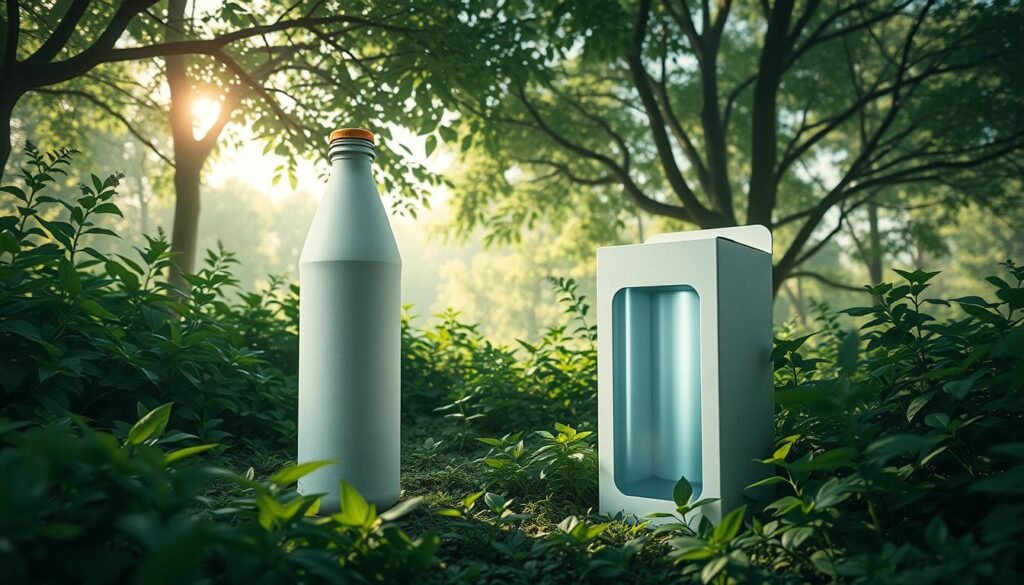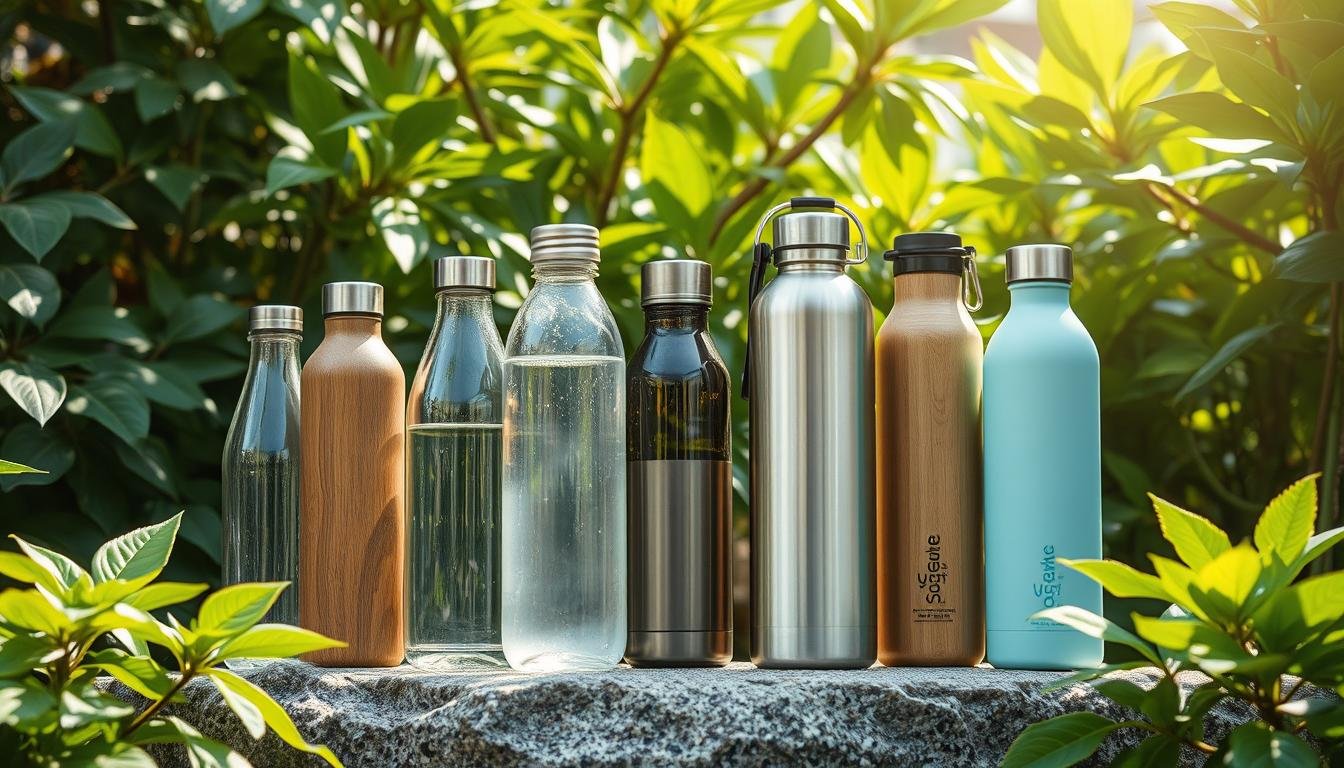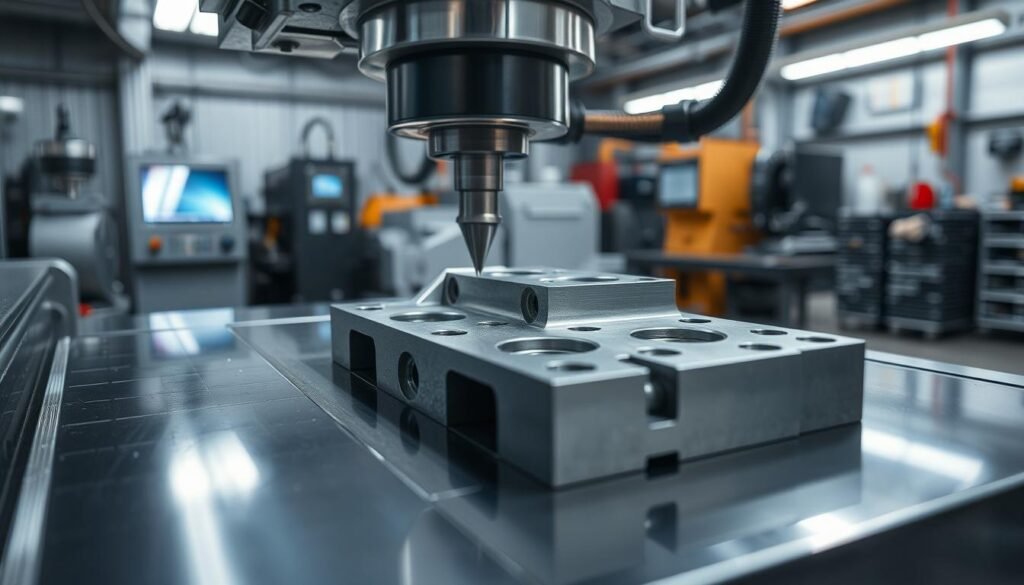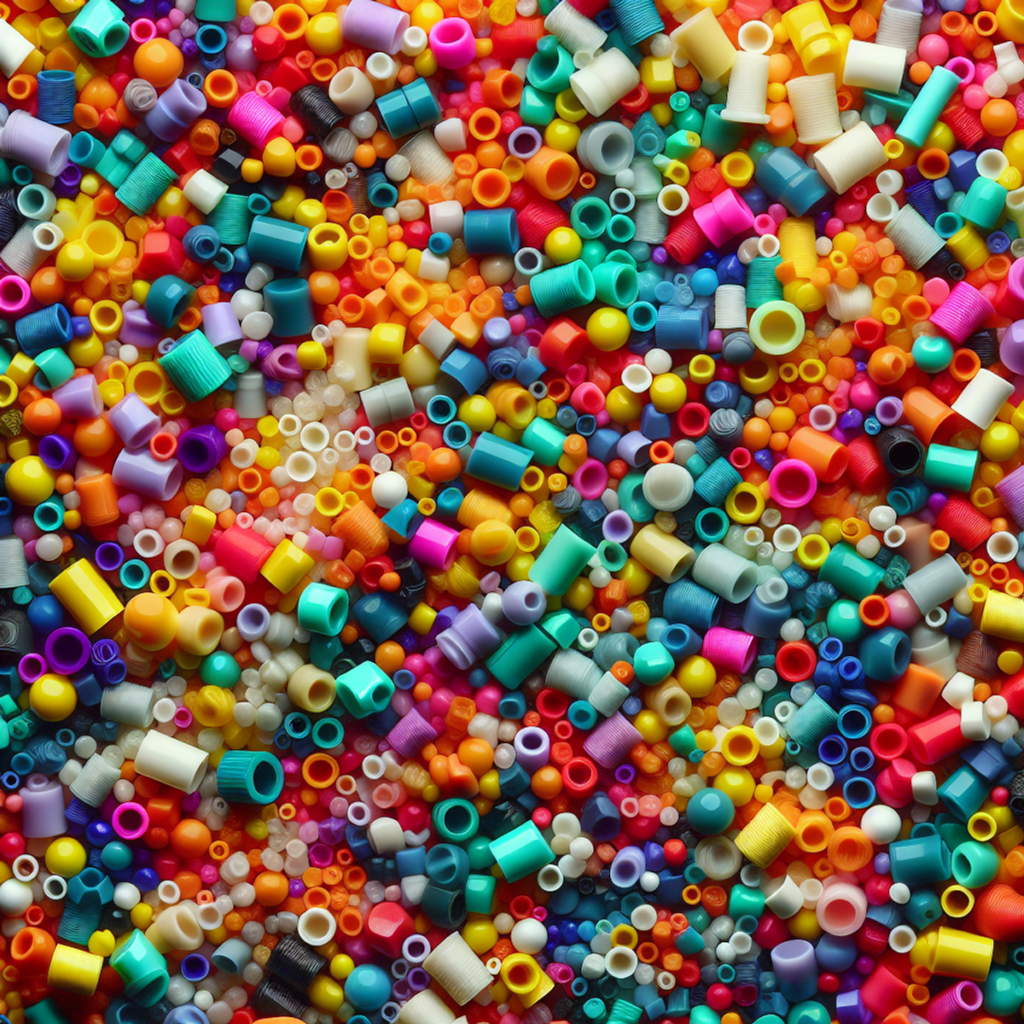About 46,000 pieces of plastic are floating in the ocean. Plastic takes over 1,000 years to break down. This shows we need better options than plastic water bottles fast.
More people now know how plastic hurts our planet. They want to use water containers that are good for the Earth. This has made the search for green water bottles very important.
The impact of plastic waste has led to a hunt for better water bottles. Now, we have many choices like glass, ceramic, and plant-based bottles. These new options help us use less plastic.
Key Takeaways
- Plastic bottles are a major contributor to environmental pollution, with an estimated 46,000 pieces floating in the ocean.
- Sustainable water bottle alternatives, such as glass, ceramic, and plant-based options, are gaining popularity as consumers seek to reduce their plastic footprint.
- Reusable bottles offer a cost-effective and eco-friendly way to transport drinking water, reducing the need for disposable plastic bottles.
- Innovative companies like Cove are developing biodegradable water bottles made from renewable materials like PHA (polyhydroxyalkanoate).
- Consumers are willing to pay a premium for fully compostable water bottles that are free from microplastics and compatible with industrial composting systems.
The Problem with Plastic Bottles
Plastic waste is a big problem, with most plastic not being recycled. This is because of sorting issues and economic challenges. In 2021, around 583 billion water bottles were used worldwide. Plastic bottles can also harm our health by releasing microplastics and nanoplastics into our bodies.
Environmental Impact
Plastic bottles harm the environment a lot. In the U.S., people buy about 50 billion water bottles every year. The bottled water market is expected to grow to $334 billion by 2023. But, only 8.4% of plastic is recycled in the U.S., with most ending up in landfills or oceans.
Health Concerns
Research found that 93% of 11 bottled water brands sampled contained microplastics. Bottled water has about 50% more microplastics than tap water. This is worrying because some plastics can disrupt hormones, leading to fertility issues and other health problems.
| Key Facts | Value |
|---|---|
| Americans buy an estimated 50 billion water bottles annually | 50 billion |
| Bottled water industry in the U.S. projected to reach by 2023 | $334 billion |
| Plastic recycled in the United States in 2017 | 8.4% |
| Bottled water brands sampled that contained microplastics | 93% |
| More microplastics in bottled water compared to tap water | 50% |
The problems with plastic bottle pollution, microplastics, and plastic waste show we need better options. We need to find ways to use less plastic.
Glass Bottles: A Sustainable Choice
As the world faces a growing plastic pollution crisis, glass bottles are becoming a better choice. Glass water bottles and reusable glass containers are great for those who care about the planet.
Glass keeps drinks fresh and cold longer than plastic. It’s also endlessly recyclable without losing quality. This makes glass a top pick for sustainable glass packaging.
| Key Advantages of Glass Bottles | Plastic Bottles |
|---|---|
| Durable and long-lasting | Easily degradable and single-use |
| Infinitely recyclable without quality loss | Limited recyclability and quality reduction |
| Maintain taste and integrity of contents | Can leach chemicals into the contents |
| Better thermal insulation properties | Weaker insulation properties |
The glass recycling process is quick, with a new bottle ready in about 30 days. In Europe, glass recycling rates are around 76%. This is much higher than plastic or wooden packaging.
“Glass containers can be reused on average 12-20 times before disposal, making them a far more sustainable choice than single-use plastic bottles.”
Even though making glass from recycled glass uses a lot of energy, using more recycled glass can save energy. With the right systems and habits, glass water bottles and reusable glass containers can help us reduce our environmental impact.
Ceramic Bottles: Durable and Eco-Friendly
Ceramic water bottles are a great choice for those looking for eco-friendly options. They are very durable and keep drinks at the right temperature. This makes them a smart choice for staying hydrated on the move.
Advantages of Ceramic
Ceramic bottles keep drinks cool for a long time without chemicals. They are made with high-quality materials and are very strong. They can handle rough use and last a long time.
These bottles come in many colors and designs. You can find one that matches your style and makes drinking water more fun. They also keep the taste of your drinks fresh and clean, without any bad taste from the bottle.
Considerations for Ceramic Bottles
- Ceramic water bottles come in sizes from 20oz to 68oz. Prices range from $39.95 to $69.95 for one bottle.
- You can buy bottles in sets or bundles. This is a good deal if you want to buy more eco-friendly ceramic containers.
- There are different lids to choose from. You can get lids with a flip straw or a push-button. These make drinking easy and fun.
- All ceramic water bottles are BPA-free. They are also approved by the FDA and EU, so they are safe and of good quality.
- Cleaning the bottles and lids is easy. They are dishwasher-safe. This makes keeping them clean simple and quick.
Choosing ceramic water bottles helps you stay hydrated and is good for the planet. They are very durable, eco-friendly, and look great. These durable reusable bottles are a great choice for anyone who wants to help the environment.
Stainless Steel Bottles: Keeping Drinks Cold
Stainless steel water bottles are a great eco-friendly choice. They keep your drinks at the right temperature. Cold drinks stay cold, and hot drinks stay hot for hours.
These bottles are made to keep drinks at the right temperature. They can keep drinks cold for up to 24 hours and hot for up to 12 hours. They’re perfect for outdoor activities, long commutes, or just enjoying a drink all day.
Stainless steel bottles are also very durable and leakproof. They’re made from 18/8 stainless steel and can handle drops, spills, and extreme temperatures. They also don’t leak, making them easy to carry around.
There are many sizes of stainless steel bottles. You can find small 20-ounce bottles or big 47-ounce ones. Some even have special lids like spout lids or straw lids.
Choosing a stainless steel bottle helps the environment. It reduces waste and supports a greener future. Using a metal water container instead of plastic bottles is a big step towards sustainability.
“Stainless steel bottles are a game-changer in the world of reusable hydration. They keep my drinks at the perfect temperature, no matter where my day takes me.”
Stainless steel water bottles are great for anyone. They’re perfect for outdoor lovers, commuters, or anyone wanting to be more eco-friendly. They keep your drinks at the perfect temperature.

Plant-Based plastic bottle Alternatives
New plant-based water bottles are coming out. They are biodegradable and even edible. This is a great way to make water bottles better for the planet.
Biodegradable and Edible Options
Some water bottles are made from plants and are safe to eat. They are not meant for drinking but are made from natural stuff. This is a big step towards less plastic and less use of fossil fuels.
Coca-Cola made a special bottle from 100% plant-based plastic. They made about 900 bottles to test. They want to use less plastic by 2025.
They also want to use leftover plants to make these bottles. This will help the planet. Coca-Cola is working with Changchun Meihe Science & Technology to make this happen.
Coca-Cola let other companies use their plant-based bottle idea in 2018. This will help make these bottles cheaper and more available.
The future of plant-based water bottles is bright. People are working hard to make them better. There are still some problems, but we’re getting closer to a greener future for water bottles.
Boxed Water and Paper Bottles
The beverage industry is looking for better ways to pack drinks. Boxed water and paper bottles are two new options. They aim to cut down on plastic waste.
Boxed water is made from 66% paper, 26% plant-based plastic, 5% aluminum, and 3% plastic. It’s still a small part of the market. But, it’s 100% recyclable, making it a greener choice. Yet, recycling it is tricky because of the plant-based plastic.
Paper water bottles are another green choice. They’re made from materials like paper or cardboard. They’re better for the planet than plastic bottles. But, they don’t last as long as reusable containers.
More people want boxed water and paper water bottles because they’re better for the planet. As we learn more about plastic waste, these options give us hope for a greener future.
“The move to Boxed Water cartons and paper water cups is just one step in a bigger journey toward sustainability.”

Even though recycling boxed water is hard, the industry is trying to get better. We can help by picking boxed water and paper water bottles over plastic. This pushes the industry toward a greener path.
The Benefits of Reusable plastic bottle
Getting a good, reusable water bottle is a wise move for staying hydrated. Reusable eco-friendly water containers save money over time. They also cut down on the harm caused by single-use plastic bottles.
Cost-Effective and Environmentally Friendly
In the U.S., a bottle of water costs about $1.45. Drinking one bottle a day for a year costs over $500. But, a reusable water bottle offers sustainable hydration for much less, saving you money and reducing waste.
Also, making plastic water bottles harms the environment a lot. It takes three times as much water to make one bottle as it does to fill it. Plus, it needs almost 2,000 times more energy than making tap water. So, reusable eco-friendly water containers are better for our planet.
Reusable water bottles last a long time. They’re made from strong materials like stainless steel, glass, or heavy-duty plastics. With care, they can last for years. This saves you money and cuts down on plastic waste, helping our planet.
“Reusable water bottles can save money by reducing healthcare costs in the long run.”
Choosing a reusable water bottle is a small but big step. By picking eco-friendly water containers, you help the planet. You also get to enjoy staying hydrated without harming the environment.
Conclusion
Plastic bottles are still popular, but there are better choices. Glass, ceramic, and stainless steel bottles are durable and reusable. They help reduce plastic waste.
Plant-based and biodegradable bottles are also great options. They offer benefits like keeping drinks hot or cold longer. They are also cost-effective and last a long time.
Choosing these bottles is a small step towards a greener future. It helps reduce our carbon footprint and protects our environment. By using eco-friendly bottles, we can make a big difference.
FAQ
What is the scale of the plastic waste problem?
Most plastic that could be recycled isn’t because of sorting and contamination issues. Also, over 583 billion water bottles were used in 2021. This adds a lot to the plastic waste problem.
What are the health concerns associated with plastic bottles?
Plastic bottles can release tiny plastic particles. These can get into our bodies and might harm our health.
How do glass bottles compare to plastic in terms of sustainability?
Glass bottles are better than plastic because they don’t break down. They keep drinks cold and don’t change taste. Plus, glass can be recycled endlessly without losing quality.
What are the advantages and considerations of ceramic water bottles?
Ceramic bottles are old but still good for the planet. They’re strong and keep drinks cold like glass. But, they’re heavy and can break. New tech makes them stronger and easier to carry.
How do stainless steel bottles compare to other materials in terms of temperature retention?
Stainless steel bottles are great because they don’t taste like metal. They keep drinks cold longer than glass because they conduct temperature well.
What are the unique features of plant-based water bottle alternatives?
Some plant-based bottles are biodegradable and even edible. They’re safe and don’t have the chemicals of plastic. They’re a new, eco-friendly choice.
What are the benefits and limitations of boxed water and paper bottles?
Boxed water and paper bottles are a new choice. They’re recyclable but don’t last as long as reusable bottles. They’re still a small part of the market.
Why are reusable water bottles the most cost-effective and environmentally friendly option?
Reusable bottles are the best choice for staying hydrated. They’re cheap and good for the planet. A good, easy-to-clean bottle can cut down on plastic waste a lot.
Source Links
- https://cedarspringswater.ca/blog/eco-friendly-alternatives-disposable-plastic-water-bottles/
- https://www.forbes.com/sites/stevensavage/2022/12/06/a-new-alternative-to-single-use-plastic-water-bottles/
- https://cleanwater.org/2020/07/29/bottled-water-human-health-consequences-drinking-plastic
- https://education.nationalgeographic.org/resource/one-bottle-time
- https://healthyhumanlife.com/blogs/news/plastic-water-bottle-pollution-plastic-bottles-end
- https://mayuwater.com/a/s/blog/glass-vs-plastic-bottles-the-sustainable-option?srsltid=AfmBOoqzdlcjvEHKuQ_gNWX0gdPjdUBAAxYj2XtP9qWrJ8JTHLyYsnlt
- https://www.bbc.com/future/article/20230427-glass-or-plastic-which-is-better-for-the-environment
- https://us.frankgreen.com/collections/reusable-bottles?srsltid=AfmBOoo75ClRSK0Dk_4XUsYzdAZo7bnecZY4VLxtc5TlibRCzFsMge9l
- https://justdays.com.au/blog/are-ceramic-water-bottles-better-than-metal-and-plastic/?srsltid=AfmBOor3wBrsdao0kuzun58CJ8J1FGFsaXnL_IEd8JbcGNNTzVTRLDFQ
- https://www.waterdrop.com/collections/steel-bottles
- https://www.camelbak.com/vacuum-insulated-stainless-steel-benefits-blog/stainlesssteelwaterbottlesdrinkware.html?srsltid=AfmBOoqX3VKEWeGGMYmdP6IYNTCoaUx5UuLZDPVCku-el2UZnM4ny_G7
- https://sigg.com/us/edelstahl-trinkflaschen/
- http://thecircularlaboratory.com/plant-based-bottles-a-solution-to-plastic
- https://www.coca-colacompany.com/media-center/100-percent-plant-based-plastic-bottle
- https://adropintheoceanshop.com/blogs/blog/is-boxed-water-better?srsltid=AfmBOoquduc5Q12DJhT8a7ulgjPl11tIQijWylXIibqAZ47KDnRqhgnj
- https://news.alaskaair.com/alaska-airlines/reducing-onboard-plastics/
- https://cleanwater.org/2023/07/10/reusable-water-bottles-understanding-reasons-why-use-them
- https://corkcicle.com/blogs/lifestyle/benefits-of-reusable-water-bottles?srsltid=AfmBOoodYjf68HKPTmxHaS3-L6Hn1bBk3Zt3XUBcoB-zeTZOEzB1IdFf
- https://lavie.bio/en/the-environmental-impact-of-plastic-water-bottles-and-how-to-avoid-it/
- https://www.acorecycling.com/the-history-of-plastic-bottles/






